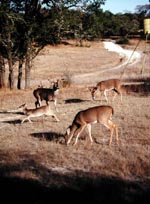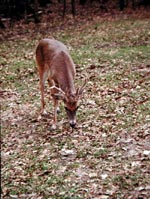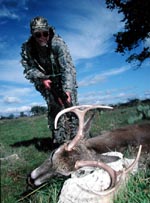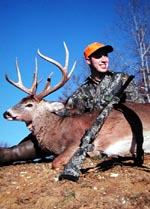
|
Features
|
|
|
|
Books
|
|
|
|
Fun & Games
|
|
|
|
Contact Us
|
|
|
John's Journal... Entry 129, Day 4
MORE PROTEIN FOR YOUR DEER QUICKER AND CHEAPER
The Advantage of Feeding Soybeans and Corn Versus High-Protein Pellets
 EDITOR'S
NOTE: During the late winter and throughout the spring and much of
the summer, maximizing the amount of protein the deer on your property
ingest will help your deerherd build stronger, healthier bodies and larger
antlers. Most sportsmen who manage their deerherds plant greenfields and
use feeders in the fall, primarily to observe deer and harvest the bucks
in their herds. However, if you want to build a healthier herd with bigger-bodied
deer and specifically bucks with heavier antlers, you must provide greenfield
plantings and supplemental feed immediately after the rut until the first
green-up. But don't stop your feeding there. If you merely insure the
survival of your herd until green-up, you haven't increased your odds
for growing bigger bucks quicker. This week we'll learn what Dr. Keith
Causey, a longtime deer biologist and Dan Moultrie, who has intensively
researched the feeding habits of deer for many years, recommend for producing
bigger, healthier deer.
EDITOR'S
NOTE: During the late winter and throughout the spring and much of
the summer, maximizing the amount of protein the deer on your property
ingest will help your deerherd build stronger, healthier bodies and larger
antlers. Most sportsmen who manage their deerherds plant greenfields and
use feeders in the fall, primarily to observe deer and harvest the bucks
in their herds. However, if you want to build a healthier herd with bigger-bodied
deer and specifically bucks with heavier antlers, you must provide greenfield
plantings and supplemental feed immediately after the rut until the first
green-up. But don't stop your feeding there. If you merely insure the
survival of your herd until green-up, you haven't increased your odds
for growing bigger bucks quicker. This week we'll learn what Dr. Keith
Causey, a longtime deer biologist and Dan Moultrie, who has intensively
researched the feeding habits of deer for many years, recommend for producing
bigger, healthier deer.
 Every
wildlife manager who tries to grow bigger and better deer on his land
must consider the cost factor. "On average, a 50-pound bag of corn
will cost about $5 a bag," Moultrie reports. "A 50-pound sack
of soybeans will cost around $6, and a 50-pound sack of high-protein pellets
may cost as much as $10 a sack. So when you compare costs, the soybeans
are only slightly more expensive than the corn and much less expensive
than the commercially-prepared high-protein pellets. However, when you
compare the nutritional value and the protein level of the soybeans with
corn and high-protein pellets, you'll see that you're dollars ahead by
feeding soybeans. The corn will have a 5- to 7-percent protein level.
The soybeans have a 35- to 47-percent protein level, depending on how
much fertilizer has been used to grow them and the quality of the soil.
Most high-protein deer pellets have 16- to 21-percent protein. To deliver
the most protein to your deer for the least amount of money, you can't
beat raw soybeans."
Every
wildlife manager who tries to grow bigger and better deer on his land
must consider the cost factor. "On average, a 50-pound bag of corn
will cost about $5 a bag," Moultrie reports. "A 50-pound sack
of soybeans will cost around $6, and a 50-pound sack of high-protein pellets
may cost as much as $10 a sack. So when you compare costs, the soybeans
are only slightly more expensive than the corn and much less expensive
than the commercially-prepared high-protein pellets. However, when you
compare the nutritional value and the protein level of the soybeans with
corn and high-protein pellets, you'll see that you're dollars ahead by
feeding soybeans. The corn will have a 5- to 7-percent protein level.
The soybeans have a 35- to 47-percent protein level, depending on how
much fertilizer has been used to grow them and the quality of the soil.
Most high-protein deer pellets have 16- to 21-percent protein. To deliver
the most protein to your deer for the least amount of money, you can't
beat raw soybeans."
Also, by using a spin feeder with a timer to feed the soybeans to the deer, you can help break the deer's nocturnal feeding habits. By setting the feeder to go off during daylight hours, you can have the deer coming to the feeder at a time when hunters can see the animals. Too, by feeding deer during the off-season, which increases the deer's nutritional levels, you can observe and monitor the growth and development of your bucks. "Using a timed feeder to feed soybeans during the off-season allows a land manger who's attempting to grow quality deer to observe the growth and development of his bucks," Moultrie says. "Then he'll know ahead of time what type and size of antlers the bucks will have in the fall when hunting season arrives."
 You
can't hunt trophy bucks if you don't have trophy bucks on the land you
hunt. Supplementally feeding soybeans in a spin feeder to deer on your
property enables you to determine the ...
You
can't hunt trophy bucks if you don't have trophy bucks on the land you
hunt. Supplementally feeding soybeans in a spin feeder to deer on your
property enables you to determine the ...
* number of bucks you'll have to hunt in each area,
* size of bucks you'll have to hunt,
* antler development of the bucks in each region you hunt,
* buck-to-doe ratio on each part of your property and
* success of your feeding and management program.
To learn more about how to use spin feeders and soybeans
to improve deerherd, write or call Moultrie Feeders at 150 Industrial
Road, Alabaster, AL 35007, (800) 653-3334, or visit the company's website
at www.moultriefeeders.com.
 TOMORROW:
CAUTIONS
TOMORROW:
CAUTIONS
Check back each day this week for more about Protein For Your Deer ...
Day 1 - Need for Protein
Day 2 - New Research
Day 3 - Peas and Corn for Bucks and Does
Day 4 - The Advantage of Feeding Soybeans
and Corn Versus High-Protein Pellets
Day 5 - Cautions